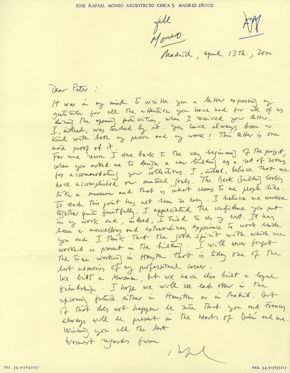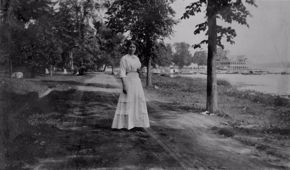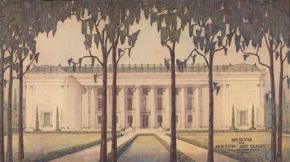Overview
About the Archives

Letter written by Rafael Moneo, architect of the MFAH Audrey Jones Beck Building, to MFAH director Peter C. Marzio, 13 April 2000.
One of the country’s first museum archives, the MFAH Archives was established in 1984 with a grant from the National Historical Publications and Records Commission.
The mission is to preserve and make available for research the museum’s permanent records. Primary source material chronicles not only the history of the MFAH, but also the artistic and cultural development of Houston. Material is also maintained from prominent artists, collectors, and figures such as the Art Guys, Manfred Heiting, Ima Hogg, and Sally Walsh.
The institutional records of the MFAH date from 1900, when the museum was founded, and include correspondence, schedules, subject files, program files, ephemera, and exhibition files. Generally, files are available for public research after 15 years, though access to some materials may be limited.
Collection Highlights: Photographs

Photo: unknown photographer, MS2114-008-018E
Future philanthropist Ima Hogg at her cottage at Lake Chautauqua, New York, undated.
Installation of Robert Rauschenberg: A Retrospective in Upper Brown gallery, February 12–May 17, 1998. Portions of the show, a comprehensive look at the artist’s 50-year career, were also on view at The Menil Collection and The Contemporary Arts Museum. The MFAH’s presentation featured his most recent work.
James Johnson Sweeney on steps of Cullinan Hall, 1960s. Sweeney served as director of the MFAH from 1961 to 1967.
The Lillie and Hugh Roy Cullen Sculpture Garden shown under construction, November 5, 1985. The garden was designed by sculptor Isamu Noguchi and opened to the public five months later.
The ground floor of the Glassell School of Art decorated for the school’s annual benefit, May 6, 1983. Following the theme “Caribbean Carnival”, large and colorful palm trees ornament the space along with artwork donated for auction.
Crowds attend the opening of Fresh Paint: The Houston School, April 7, 1985. The exhibition drew national attention to the Houston art scene.
The MFAH commissioned Frank Stella to design the decorations for the “Stella by Starlight” Grand Gala Ball. His designs were enlarged and transferred to walls in the Upper Brown gallery by Core artists from the Glassell School, October 1982. The original drawings remain in the museum’s art collection.
Land north of Cullinan Hall is excavated for the construction of Brown Pavilion, January 1972. Brown Pavilion was the second Mies van der Rohe-designed addition to the museum’s original building and took two years to complete.
Photo: unknown photographer, RG05-743-004
Ruth Pershing Uhler, curator of education, served in a number of capacities—including exhibition planning, special events, children's programming, docent training, and membership promotions—when the MFAH staff was very small. (photo c. 1950s)
The Houston Art League celebrates its 25th anniversary with a performance by the Baby Band of the United Methodist Church, April 13, 1925. The League, the MFAH’s parent organization, had opened the museum building just one year earlier.
The Contemporary Arts Museum, Houston held its first exhibition, This is Contemporary Art, in the MFAH’s Wiess gallery, October 31–November 14, 1948. The show sought to illustrate “the important contribution contemporary arts make to modern living” in items from fabrics and wallpaper to advertising and architecture to painting and sculpture.
Rosemary Larson brings her class of four- and five-year-olds on a nature study tour of the Museum garden, 1961. The leaves they gathered were part of an art project. The MFAH has offered art classes for children since 1937.
Photo: Jim Culberson, RG16-035-001.
The MFAH Archives photograph collection contains 184,000 images that document the history of exhibitions, architecture, and programming at the MFAH. The collection is composed primarily of exhibition installation views; photographs of museum openings and events with members of the art community and museum staff; interior and exterior views of the MFAH campus and its environs; and architectural models. An additional 52,000 photographic images reside in manuscript collections, documenting subjects such as prominent Houston families, Houston gardens, exhibitions at the CAMH (Contemporary Arts Museum Houston), and contemporary artists represented by the Garth Clark Gallery. Photographic material may be reproduced in accordance with copyright laws.
Collection Highlights: Architecture

MFAH Architectural Collection, RG35-017-003
After years of planning by the Museum’s founding organization, the Houston Art League, the original building opened on April 12, 1924. Four additions were subsequently built, two by Ludwig Mies van der Rohe who changed the orientation of the building toward the north. In 1998 the Museum board named the building in honor of Caroline Wiess Law for her lifetime dedication to the MFAH. Image shows rendering of the south façade, William Ward Watkin, c. 1922.
The original building was designed by William Ward Watkin, supervising architect for Rice and later first chair of its architecture department, to be built in phases. His original design is shown here. The complete west wing and a section of the east wing comprised the first addition to the building. The wings opened in 1926. Plans to complete the additional wings around a center garden court were never realized.
.
The museum board departed radically from Watkin’s plans with the addition of the Blaffer Memorial Wing in 1953. The wing’s unadorned façade broke with the beaux arts design of the original building and was the first indication that the board was entertaining a modern aesthetic. The wing was designed by Kenneth Franzheim, the city’s foremost commercial architect of the era and an American Institute of Architects fellow and Award of Merit recipient. Image shows original Blaffer drawing, Elevations and Details – July 1952.
The following year, Bauhaus master Ludwig Mies van der Rohe was contracted to expand the facilities with funds provided by life trustee, Nina Cullinan. Mies designed a major new addition, Cullinan Hall, which was completed in 1958 and transformed the building into a paradigm of the modern aesthetic while successfully incorporating the existing Watkin design. Image shows original blueprint from Mies Van der Rohe’s shop – East and West Elevations of Cullinan Hall, 1950.
Mies also designed the Brown Pavilion, which was completed in 1974 after his death with funds provided primarily by the Brown Foundation. Upon the pavilion’s opening, a New York Times review observed, “Mies style for all its obvious modernity is essentially rather classicizing, and so the relationship between the [Watkin and Mies] wings, which are superficially so different, is nonetheless comfortable, nothing in Mies’s architecture tries to invalidate the older building.” Cullinan Hall and the Brown Pavilion are the only Mies-designed museum projects in the nation. Image shows Upper Brown gallery looking east, construction completed but empty, 1974.
Well-known Houston architect John F. Staub designed a home for Ima Hogg and her brothers in 1927 which became the museum’s American decorative arts wing, Bayou Bend Collection and Gardens, after its donation in 1957. In 1952, John F. Staub also designed Harris and Carroll Sterling Masterson’s home, Rienzi, which became the museum’s European decorative arts wing following its donation in 1991. Image shows an original John F. Staub drawing of Elevations and Details of Stairways, Doors, Columns and Cornices, Bayou Bend, 1925.
In 1992, following a two-year search, the museum board chose internationally acclaimed Rafael Moneo to design its new building, which bears the name of life trustee, Audrey Jones Beck. Moneo would be awarded the coveted Pritzker Architecture Prize in 1996 shortly before construction begins in early 1997. Image shows preliminary plans for the Beck building, created by Moneo, 1996. When the Audrey Jones Beck Building opened on March 25, 2000, it marked the centennial of the museum's founding and the culmination of fifteen years of strategic planning and expansion initiated by the board. Those years had also witnessed the addition of the Alfred C. Glassell, Jr. School of Art, an off-site facility for the Conservation and Archives departments, and the Glassell Junior School of Art/MFAH Central Administration.
Model of Rafael Moneo's innovative natural lighting system for the Beck Building, utilizing indirect sunlight to illuminate the galleries.
Between 2000-2002, the landscape architectural firm, Jon Emerson & Associates, Inc., proposed plans to refresh the gardens at Rienzi, the museum’s European Decorative arts center. The gardens were originally designed for the Mastersons by Ralph Ellis Gunn, one of the state’s first landscape architects. Image shows the overall landscape design for Rienzi by Emerson.
The Lora Jean Kilroy Visitor and Education Center at Bayou Bend
The architectural collection documents the construction history of the MFAH campus, including Bayou Bend and Rienzi. In addition to architectural drawings in a variety of formats, the collection contains account statements, architectural specifications, project histories, and correspondence. Among the highlights are a 1922 rendering of the south facade of the original building by William Ward Watkin; plans for Cullinan Hall, Brown Pavilion, and a never-executed sculpture garden by Ludwig Mies van der Rohe; a sketch of the Beck Building by Rafael Moneo; and alternate renderings of Bayou Bend's dining room by William Mackay. The Sally Walsh papers include blueprints, sketches, and layouts.
Textual records are accessible for public research 15 years after their creation. Architectural drawings are available for viewing on-site by appointment, but may not be traced or otherwise reproduced. Some architectural drawings and records may be closed to the public for confidentiality or security purposes.
Collection Highlights: Audio-Visual
The audio-visual collection consists of more than 3,000 audio recordings and moving images—primarily interviews, lectures, ceremonies, and other events held at the MFAH. In these recordings, scholars, educators, curators, and artists speak on topics relating to exhibitions and the museum’s art collections. Examples include classes, tours, docent training, and annual events such as the Ruth K. Shartle Symposium. Also among the recordings are publicity materials; a number of short documentary films produced in conjunction with exhibitions; and more than 100 lectures by the Rice Design Alliance from 1975 to 2000.
The collection is catalogued in a database that contains items primarily from institutional department records and also from manuscript collections. Of note are the recordings of the Ceramic Millennium Conference from the Garth Clark Gallery archive; interviews with important Houston and Texas artists from the Fresh Paint video collection; and interviews with prominent international jewelry artists from the Helen Williams Drutt audio collection.
